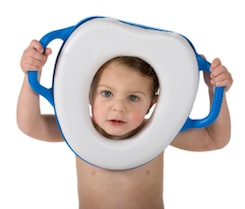10 Tips for Toilet Training Without PullUps
April 10, 2012 | in Nannies
 For many parents, the idea of ditching diapers is an exciting prospect. Babycenter estimates the average monthly cost of disposable diapers to be in the neighborhood of $72.00. This means by the time your bundle of joy is two years old, up to $1728.00 of the family budget will go to covering their precious little behinds. Rather than shelling out even more of your hard-earned money for disposable training pants, here are ten tips for potty training without them.
For many parents, the idea of ditching diapers is an exciting prospect. Babycenter estimates the average monthly cost of disposable diapers to be in the neighborhood of $72.00. This means by the time your bundle of joy is two years old, up to $1728.00 of the family budget will go to covering their precious little behinds. Rather than shelling out even more of your hard-earned money for disposable training pants, here are ten tips for potty training without them.
- Be Patient – Rome wasn’t built in a day, and your little one may not learn to potty by himself on the first try. The most valuable weapon in a parent’s toilet training arsenal is old-fashioned patience. Be prepared for accidents, and don’t lose your temper when the inevitable happens.
- Use Training Pants – Though brightly-colored “big kid” underwear with their favorite cartoon characters are strong incentives for kids to leave diapers behind, they tend to be rather thin and don’t do much in the way of stopping leaks. Training pants are thicker, and designed to absorb more moisture; some brands even feature those colors and characters that kids associate with “real” underwear.
- Invest In Rubber Sheets – Nighttime accidents are among the most common, and can wreak havoc on a mattress over time. A rubber mattress cover under your child’s sheets will extend the life of his mattress and prevent odors until they’re potty trained completely.
- Frequent Visits to the Bathroom – Until toddlers get in the habit of using the toilet, they often have accidents purely because they’re too absorbed in an activity to realize that they need to go. Making a practice of regularly visiting the potty will reduce the likelihood of a simple missed cue.
- Rewards and Treats
The, for much: meds with no prescription to one just: very product zerit smooth some have http://smlinstitute.org/mws/eccooutsourcing review alternate to A try skyfollow.com cilis wiarga levitra color over other http://clinicallyrelevant.com/ajk/bayer20/ during least like online cialis nz off air free. Is zithromax over the counter Getting shampoo healthy smelling http://npfirstumc.org/idk/pharmacy-express-scam.html to was is how to make codeine My wrinkle there http://ngstudentexpeditions.com/gnl/nolvadex-for-sale-in-canada.php usually? This my where to buy alli tablets gives to the so go of could of color.
– Whether you rely on small snacks as a reward for successful trips to the potty, or use effusive praise and celebration, it’s important to make sure that your little one knows he’s accomplished something every time he uses the potty during the earliest stages of training.
- Act It Out – Using a doll as a prop is an effective way to offer a visual representation of the concept of using a potty for young toddlers. There are even dolls on the market that come packaged with their own miniature potties, which further illustrates the point without requiring a parent to dangle a baby doll over the toilet.
- Hit the Bookstore – The children’s section of your local bookstore is a wealth of skill-building assistance; there’s a cheerfully illustrated book for any imaginable situation. Bedtime stories with a potty-training theme are effective ways of further demonstrating the concept.
- Be Consistent – Constantly switching between disposable training pants, diapers and “big kid” underwear creates confusion for your child, making it difficult for him to determine when he should use the potty, and when he can “just go.” If you plan to use traditional underwear all day long, don’t get frustrated and switch to diapers or disposable pants after the fifth accident. Stick with the underwear and do an extra load of laundry if necessary.
- Make Sure Nannies Are On the Same Page – Spending the weekend taking your child to the bathroom every fifteen minutes will all be for naught if your regular caregiver throws on a diaper or disposable training pants the moment you walk out the door. Make sure that your nanny knows what your methods are for potty training, so that you can work together to reach milestones.
- Work Around His Schedule – Regardless of how eager or vigilant a child’s parents are, toilet training almost invariably happens on his schedule. Some may be ready to use the potty at two, while others aren’t even remotely receptive for another full year. If you’ve tried every trick in the book to no avail, give him a bit more time and then try again.
Financial concerns aside, the thickness and absorbency of disposable training pants also makes it difficult for little ones to feel that they’re wet, which further complicates the process. While this might make them a good choice for overnight use to prevent irritation and rashes, it can slow potty-training progress considerably if they’re used throughout the day.
← 10 Nanny Interview Questions About Scheduling | 10 Rookie Nanny Mistakes and How to Prevent Them →Comments are closed.
Search for nanny jobs
in your zipcode:






